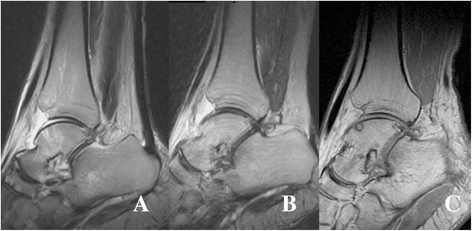Six-year survival of reimplanted talus after isolated total talar extrusion: a case report
- PMID: 29241447
- PMCID: PMC5731080
- DOI: 10.1186/s13256-017-1517-7
Six-year survival of reimplanted talus after isolated total talar extrusion: a case report
Abstract
Background: Open total extrusion of the talus without concomitant fracture is an extremely rare injury. We present 6-year follow-up data of a patient treated using a temporary spanning external fixator and less invasive single K-wire fixation.
Case presentation: A 55-year-old Asian man who had a totally extruded talus without fracture underwent immediate reimplantation surgery. A spanning external fixator with single antegrade K-wire fixation was applied to maintain the reimplanted talus. During 6 years of follow-up, he could walk without aids and could squat, corresponding to an American Orthopaedic Foot and Ankle Society score of 85. We found that the suspect lesion that was evident at 6 months after surgery had disappeared at 12 months postoperatively on the basis of sequential follow-up magnetic resonance imaging. There was no evidence of osteonecrosis of the dislocated talus at the final follow-up.
Conclusions: In patients with a totally extruded talus, a surgical strategy including immediate reimplantation of the talus and a temporary spanning fixator with single K-wire fixation might be useful to allow early mobilization around the ankle joint and to prevent additional damage of the foot without significant complications.
Keywords: Osteonecrosis; Reimplantation; Revascularization; Talus; Total extrusion.
Conflict of interest statement
Consent for publication
Written informed consent was obtained from the patient for publication of this case report and any accompanying images. A copy of the written consent is available for review by the Editor-in-Chief of this journal.
Competing interests
The authors declare that they have no competing interests.
Publisher’s Note
Springer Nature remains neutral with regard to jurisdictional claims in published maps and institutional affiliations.
Figures





References
Publication types
MeSH terms
LinkOut - more resources
Full Text Sources
Other Literature Sources
Medical

